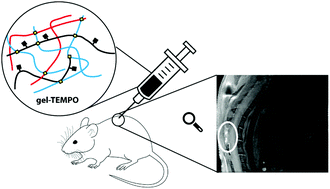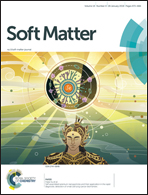Microwave-assisted synthesis of TEMPO-labeled hydrogels traceable with MRI†
Abstract
Polymer functionalization strategies have recently attracted considerable attention for several applications in biomaterials science. In particular, technological advancements in medical imaging have focused on the design of polymeric matrices to improve non-invasive approaches and diagnostic accuracy. In this scenario, the use of microwave irradiation of aqueous solutions containing appropriate combinations of polymers is gaining increasing interest in the synthesis of sterile hydrogels without using monomers, eliminating the need to remove unreacted species. In this study, we developed a method for the in situ fabrication of TEMPO-labeled hydrogels based on a one-pot microwave reaction that can then be tracked by magnetic resonance imaging (MRI) without using toxic compounds that could be hostile for the target tissue. Click chemistry was used to link TEMPO to the polymeric scaffold. In an in vivo model, the system was able to preserve its TEMPO paramagnetic activity up to 1 month after hydrogel injection, showing a clear detectable signal on T1-weighted MRI with a longitudinal relaxivity value of 0.29 mM s−1, comparable to a value of 0.31 mM s−1 characteristic of TEMPO application. The uncleavable conjugation between the contrast agent and the polymeric scaffold is a leading point to record these results: the use of TEMPO only physically entrapped in the polymeric scaffold did not show MRI traceability even after few hours. Moreover, the use of TEMPO-labeled hydrogels can also help to reduce the number of animals sacrificed being a longitudinal non-invasive technique.



 Please wait while we load your content...
Please wait while we load your content...